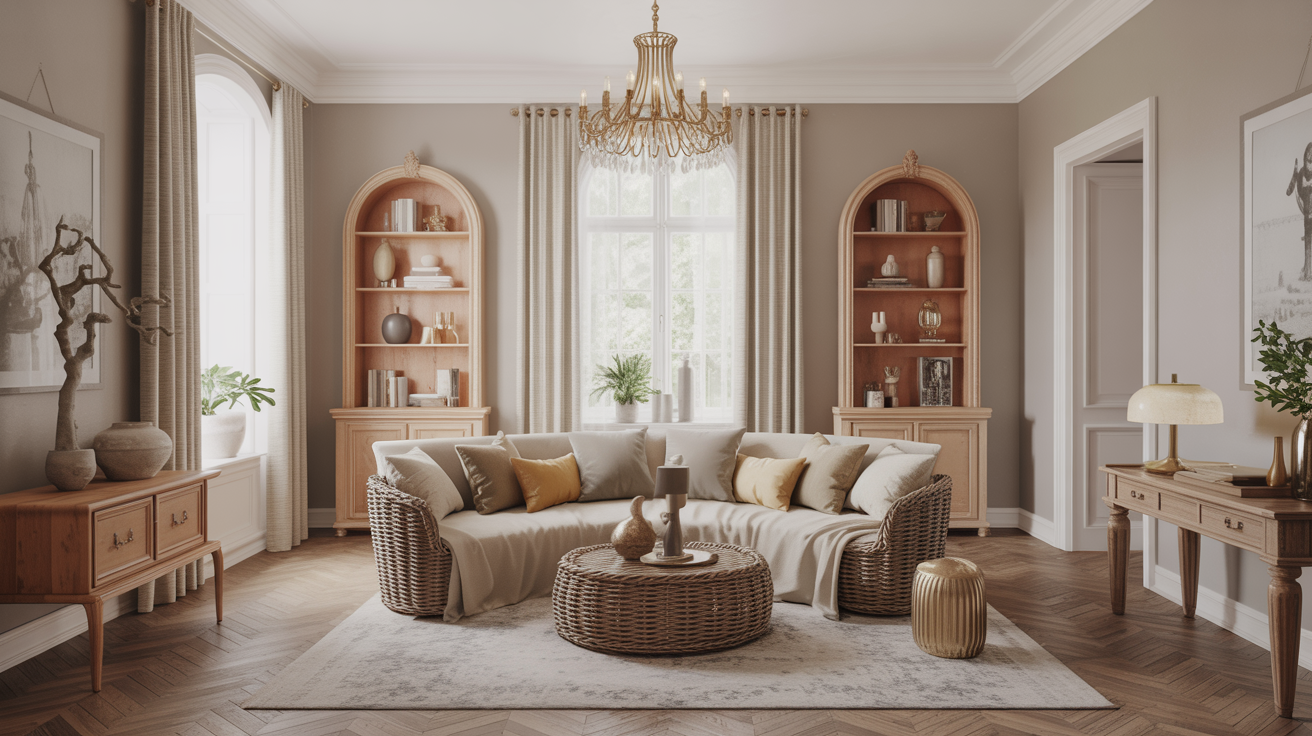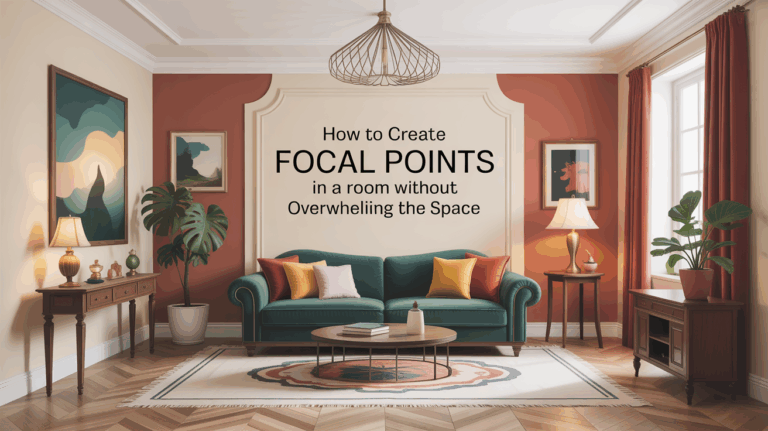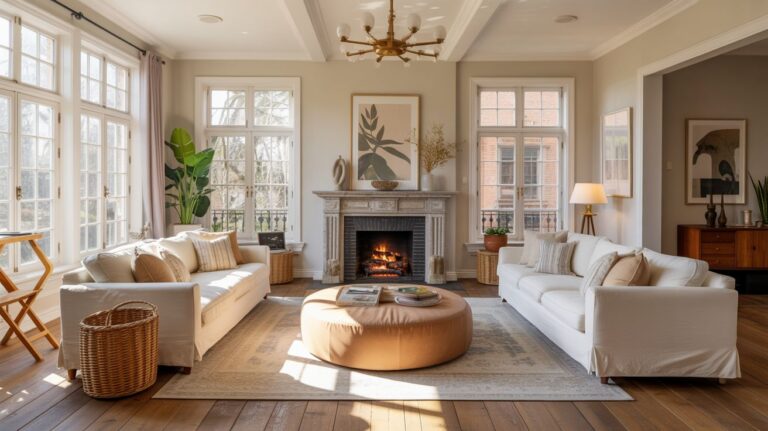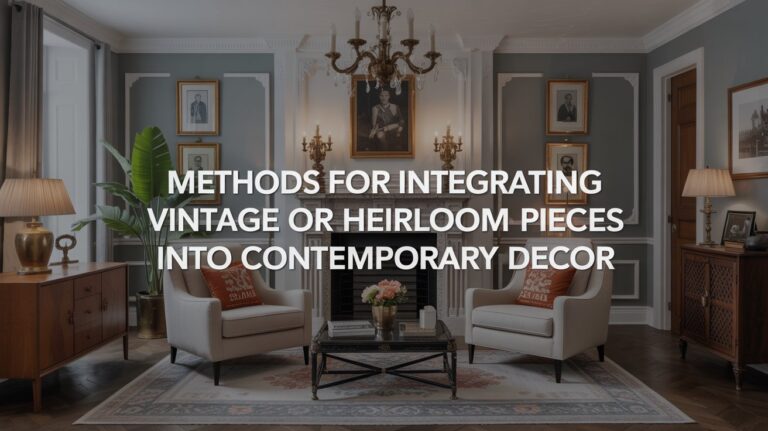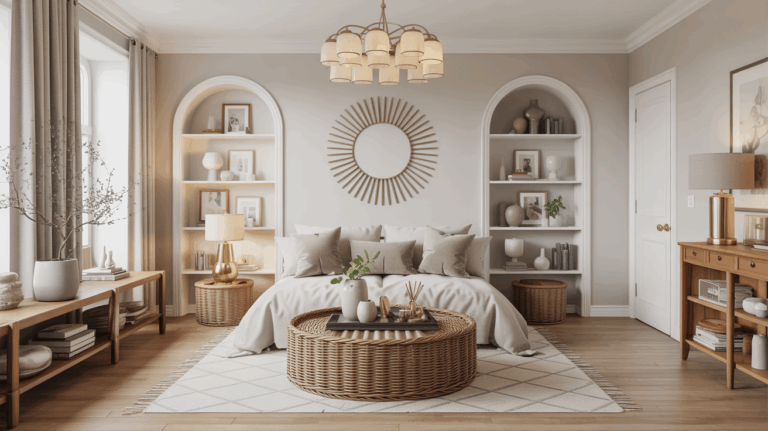How to Craft a Timeless Room Decoration Plan That Ages Gracefully
I have been, or can be if you click on a link and make a purchase, compensated via a cash payment, gift, or something else of value for writing this post. As an Amazon Associate, I earn from qualifying purchases. Please read my full Affiliate Disclosure for more information.
Start with a durable color base that adapts to light and season, then choose timeless furniture silhouettes that support flow without shouting style. Layer your lighting for flexibility—ambient, task, and accents that evolve with the room. Select durable materials, repairable details, and consider vintage touches for character. Build a flexible palette you can refresh with small swaps, plus smart storage to keep surfaces calm. If you keep refining these moves, more timeless tricks await.
Key Takeaways
- Define a timeless mood with enduring color palettes, balanced by a tonal ladder and room for seasonal updates through reversible textiles and accessories.
- Choose furniture silhouettes that are proportionate, low-profile, durable, and blend vintage with modern minimalism for longevity.
- Layer lighting (ambient, task, accent) with flexible controls to support evolving furniture while avoiding harsh shadows.
- Build a flexible decor base: core colors and materials, layered with easily swapped accents and documented swaps.
- Plan strategic layouts with clear focal points, storage, and clutter control to maintain calm, functional spaces that age gracefully.
Choosing Enduring Color Palettes
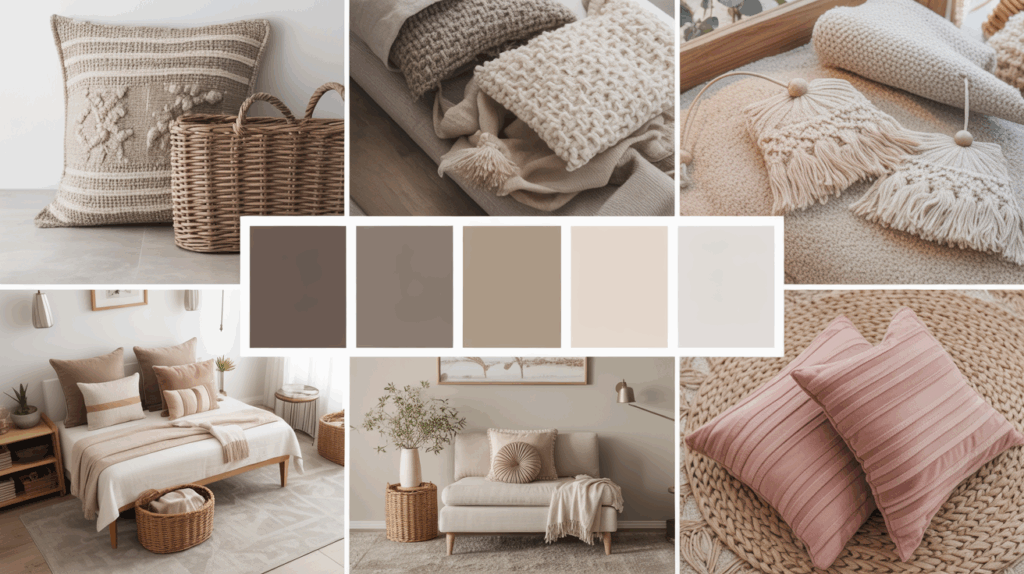
Choosing enduring color palettes starts with a clear vision of the room’s mood and a practical sense of how it will age. You’ll align color with lighting, space, and function, selecting base tones that endure. Build a tonal ladder: a dominant hue, supporting shield tones, and subtle accents. Incorporate vintage accents thoughtfully to anchor character without overpowering balance. Plan seasonal updates through small, reversible changes—throw pillows, textiles, accessories—that refresh the scene without major overhaul. Consider natural materials and muted contrasts to preserve harmony. Test samples in multiple lighting moments, refining until the palette feels timeless and adaptable for years.
Selecting Timeless Furniture Silhouettes
Selecting timeless furniture silhouettes begins with a clear sense of proportion and purpose: pieces should support the room’s flow, not compete with it. You’ll choose shapes that read cleanly from every angle, favoring low, grounded profiles over fussy flourishes. Consider how each silhouette relates to scale, sightlines, and traffic patterns so nothing feels crowded. Blend vintage accents with modern minimalism to create a cohesive narrative: a midcentury chair beside a streamlined sofa, a carved wood sideboard next to glass and steel. Favor durable materials and subtle details that age gracefully, ensuring versatility as trends shift and tastes evolve.
Layering Light for Longevity
Layered illumination is your foundation for a timeless look, starting with basic ambient, task, and accent layers. You’ll balance multiple light sources to avoid harsh shadows and brighten corners without glare. By pairing thoughtful positioning with simple controls, you set the stage for longevity in mood and function.
Layered Illumination Basics
Layered illumination isn’t just about how bright a room is; it’s about building a usable, cozy atmosphere by combining ambient, task, and accent lighting. You’ll balance sources to create depth, not glare, and you’ll see how ambient glow sets mood while practical task lights support reading, cooking, or writing. Think in layers: soft background glow, focused beams for work, and subtle highlights to sculpt shapes. This approach makes spaces feel timeless, flexible, and welcoming, even as furniture changes. With layered lighting, you gain longevity in design—consistency, comfort, and clarity that ages gracefully.
Mulitple Light Sources Balance
Effortless balance comes from coordinating a few well-chosen light sources so they work as a single system, not competing beams. You’ll blend ambient glow with focused task layering, ensuring each layer supports the others. Start by defining zones: a soft foundation, a practical work area, and a spotlight for accents. Use dimmable fixtures to adapt as moods shift, preserving cohesion. Avoid overloading any single source; let shadows add depth, not clutter. Aim for a consistent color temperature, then tweak brightness for readability and comfort. Regularly reassess, since longevity comes from deliberate, evolving balance rather than fixed rigidity.
Durable Materials and Smart Shopping
Durable materials save you time and money, so start with core choices like solid wood, high-density fiberboard with laminate, or porcelain tile that won’t scratch easily. You’ll weigh longevity against cost, and plan for repairability. Prioritize pieces with stable finishes and simple silhouettes that endure wear. When shopping, compare warranties,材evidence of craftsmanship, and maintenance requirements to curb surprises. Seek vintage accents for character without sacrificing durability, and opt for eco friendly finishes to minimize impact. Track performance in real rooms, not ads, and favor suppliers offering transparent provenance. Smart shopping means patience, measurements, and a clear renovation timeline.
Building a Flexible Decoration Palette
From solid foundations and smart shopping, your next move is shaping a flexible decoration palette that can evolve without constant rework. You choose a core color family and a few timeless materials, then layer in seasonal accents and decorative accessories to refresh rooms without a full redo. Build compatibility by testing tones in lighting at different times of day, so harmony remains under varied conditions. Document swaps as small projects, not overhaul moments, and store samples for quick reference. Prioritize pieces with provenance or story, so each update feels intentional, not arbitrary. This approach keeps spaces coherent while inviting gentle evolution.
Texture and Pattern Mixes That Last
Texture and pattern mixes that last hinge on balance: you blend quiet, solid textures with subtle patterns to avoid visual noise over time. You prioritize textural contrast by pairing matte fabrics with slight sheen, and you test scale to prevent clash. Pattern layering is deliberate, using one dominant motif plus supporting accents so surfaces read as cohesive rather than busy. Consider rhythm: alternate textures across rooms, not just within. Switch to calm neutrals as anchors, then introduce intentional pops. Reassess annually, swapping small textiles instead of major revamps. With thoughtful mix, your space ages gracefully, remaining calming, unified, and inviting.
Practical Storage Solutions for a Calm Space
You’ll start with hidden vertical storage to keep everyday clutter out of sight, while maintaining easy access. Consider multi-surface setups that tuck lamps, books, and baskets into calm, tactile zones, so every space earns a quiet behavior. Plan zone-by-zone organization to balance function and flow, letting storage choices reinforce a timeless, uncluttered feel.
Hidden Vertical Storage
Hidden vertical storage quietly transforms a small, cluttered room into a calm, efficient space. You leverage height, not floor area, to gain organization without visual mess. Choose concealed shelving that blends with walls, so storage remains discreet yet accessible. Slim cabinets, tall niches, and open cubbies invited by adjustable racks prevent overstuffing, while labeled bins keep momentum. Plan routes so you can reach essentials from seating areas, reducing habit-driven clutter. Integrate pull-out baskets for flexible use and maintain symmetry to preserve a timeless feel. This practical approach supports serenity, clarity, and ease, guiding you toward a refined, functional home.
Multi-Purface Surfaces
Multi-surface storage brings order to a calm room by matching function to every zone. You’ll choose surfaces that support daily routines without visual clutter, pairing hidden compartments with accessible ledges. Think wall mounted art that doubles as a shelf, so decorative pieces breathe while lightly storing small essentials. Use multi textured fabrics for cushions and hides, layering texture without overwhelming color. Opt slim consoles and wall shelves to keep pathways clear, and designate a dedicated drop-spot near entry for keys and bags. Regularly assess each surface’s purpose, swapping items as needs shift, preserving balance, simplicity, and quiet efficiency.
Zone-by-Zone Organization
Zone-by-zone organization takes the calm you’ve built with multi-surface storage and puts it into action by mapping how each area is used. You’ll designate zones for daily essentials, overflow items, and display spaces, then tailor storage to fit those roles. Start with a simple inventory, label boxes, and set clear boundaries so utensils, cables, and documents don’t drift. Use wall art and decorative accessories to cue purpose without clutter, rotating pieces seasonally to refresh the mood. Keep a quick-access station for keys and chargers, and a hidden drawer for infrequently used items. This deliberate layout reduces search time and boosts serenity.
Simple Updates to Refresh Without Overhaul
A few simple updates can refresh a room without a full overhaul, and you’ll see noticeable results fast. You scan the space, identify focal points, and apply deliberate tweaks. Begin with lighting: switch to warm bulbs, layer shaded lamps, and adjust dimmers for mood. Swap a few textiles—a throw, cushion covers, or a rug—to shift texture and color subtly. Add a piece of minimalist decor or a small vintage accent to anchor the theme without crowded visuals. Repaint one wall or refresh trim to lift contrast. Finally, declutter surfaces, curate what remains, and measure impact before broader changes.
Conclusion
You can make a room feel eternal by choosing quiet color, enduring silhouettes, and light that adapts with time. Build your palette with neutrals and a few flexible accents, so updates don’t demand a overhaul. Pick durable materials and smart storage that hide clutter. Layer textures and pattern with intention, not trend. Keep a small, simple refresh kit to tweak essentials. When you design with flexibility, your space ages gracefully—and you’ll love it for years to come.
